By Mike Tanner, Photos By Mike Tanner
As anyone who watches TV can tell you, makeovers are hot. Don’t like your body, call in the plastic surgeons. Don’t like your house, call in the construction crew and interior designers. Don’t like your lifestyle, call in the Fab Five.
But what do you do if you’re a city with a tired, thirtysomething-year-old golf course? The fairways don’t drain. The greens aren’t up to USGA specifications. The irrigation system leaks worse than a rusty bucket.
Well, if you’re the city of Virginia Beach, Virginia, you call in Kevin Tucker Design Group to direct a tee-to-green makeover of your showcase municipal layout, Red Wing Lake Golf Course.
When she made her debut in July 1971, Red Wing was a par-72 hottie. She was long at 7,100 yards and lush with wall-to-wall Bermudagrass. She was sporty too. More than 80 bunkers and five man-made lakes challenged players to swing with both power and accuracy.
Red Wing could drop some names. Her designer was George Cobb, a respected Greenville, South Carolina-based golf course architect who worked primarily in the mid-Atlantic region. A grand opening exhibition played in September 1971 featured Lee Trevino, the reigning US, British and Canadian Open champion.
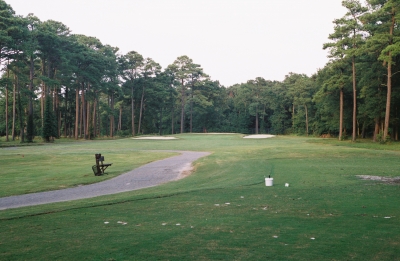 |
| The new par-3 fourth hole will be bunkerless and players will have to carry a small pond between the teeing ground and putting surface. |
She wasn’t exactly a pushover, but Red Wing did yield a course record 67 (four birdies, one eagle and one bogey) to the Merry Mex. The other notable players that day were Virginia State PGA champion Claude King, six-time Virginia Amateur champion Vinny Giles and a talented local teenager by the name of Curtis Strange.
Cobb can’t be blamed for Red Wing’s eventual decline. He did the best he could with what he had to work with. The land is in a flood plain — hemmed in on two sides by federal and state military facilities. Pushup greens, built by piling up dirt from the site, were common in his day. The irrigation system was modern for its time.
According to John LaFoy, a practicing architect (Kiskiack in Williamsburg is one of his designs) and former associate of Cobb, Red Wing’s creator was typical of golf course architects working in the years following World War II.
“George Cobb and Ellis Maples and their contemporaries worked in the Robert Trent Jones era. It wasn’t a golden age of architecture, and maybe George’s design features weren’t as dramatic as those architects, but he had a complete understanding of golf strategy. I think George is beginning to get credit for his skill as a golf architect,” said LaFoy in a telephone interview.
LaFoy went on to say of Cobb, “He was born into a family of golfers and raised in Savannah, Georgia. George was artistic and enrolled at the University of Georgia where he studied landscape architecture in the 1930s.” He added, “During World War II, George was a marine and the base commander at Camp Lejeune, North Carolina wanted a golf course built as a physical rehabilitation facility. George had served as the construction chief for a course built earlier at Parris Island, so he got the job.”
Today, Camp Lejuene’s Paradise Point Golf Course features Cobb’s first design, the Gold Course, which opened in 1945 and a 1943 vintage Fred Findlay layout, the Scarlet Course.
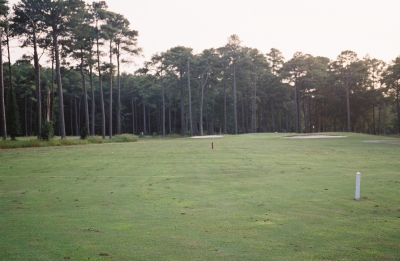 |
| Red Wing's revamped par-4 sixth hole will confront players with an approach shot over a new pond. |
Red Wing was designed and built near the end of Cobb’s career. He died in 1987 and left a legacy of more than 300 playable and affordable courses for generations to enjoy.
Red Wing never was and never will be one of the spectacular beauties that gets listed in the “Top Courses You Should Mortgage Your Home or Suck Up To A Member to Play.” But she is the kind of good-looking local gal that attracts a band of loyal devotees (upwards of 40,000 annual rounds in her heyday) and her fading charms did not go unnoticed.
Richard Nutter, Golf Course Administrator for Virginia Beach’s Parks and Recreation Department, started working for the city in 1975. “At that time, the city had a limited lease on the golf course property and was working on extending the lease,” said Nutter.
Over the next two decades, there was talk of making Virginia Beach a golf destination a la Myrtle Beach. ‘‘The question was ‘should Red Wing be a recreational amenity as well as a golf destination for visitors?’” explained Nutter. By 1996 a citizen’s commission recommended that Red Wing be improved and a second 18-hole course built next to it, but no action was taken.
As the calendar pages turned, the debate over Red Wing continued. In 2000, a Parks & Recreation commission conducted a series of public hearings that presented various scenarios for renovating the course that ranged from a total redesign by Arthur Hills to a more modest makeover of the existing layout.
“Talking to our customers and getting input from the community was vital,” Nutter explained. “It’s really important to maintain the loyalty of our existing patrons while trying to attract new ones.”
At the end of that process, “the recommendation presented to city council was that the Parks and Recreation Department should renovate the existing layout,” said Nutter.
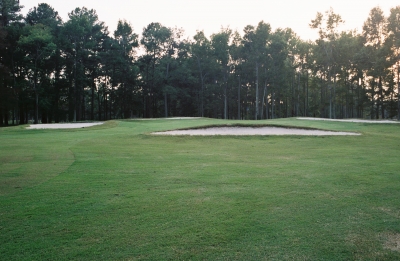 |
| Beach erosion: The redesigned par-3 eighth hole will offer only a single bunker on the left side of the green. |
According to a pamphlet produced by the American Society of Golf Course Architects, some of the most common reasons for remodeling a golf course include: The need for USGA-type greens; inadequate drainage; adding, reworking or eliminating bunkers; replacement of the irrigation system; increasing the speed of play and eliminating unsafe playing conditions. Red Wing needed attention in all those areas.
But before any of those things could be done, the city needed a golf course architect. According to Nutter, “Twenty-three architects answered our Request for Proposal. That list was narrowed down to four finalists, who were interviewed in person before selecting the winning bid.”
Enter Kevin Tucker, who works out of Nashville, Tennessee. A solidly constructed, gregarious man whose accent reveals his Southern origins, Tucker graduated from Mississippi State University in 1973 with a degree in landscape architecture.
Asked about his background, Tucker said, “I had the good fortune to go to work in Ft. Lauderdale, Florida in 1973. Florida was booming and what I did primarily was planning for golf course communities. I’ve done about 25 renovations prior to Red Wing. The majority have been municipal or government golf courses.”
Tucker has provided design services for more than fifty courses. In 2003, Golf Digest honored his Koasati Pines Golf Course in Louisiana as the seventh best New Upscale Daily Fee Course in the U.S.
How does Tucker plan to put the color back into Red Wing’s faded features? First of all, he’s going to leave the routing alone. It’s more cost-effective to leave the holes where they are, and besides, Red Wing’s major problems have more to do with conditioning than positioning.
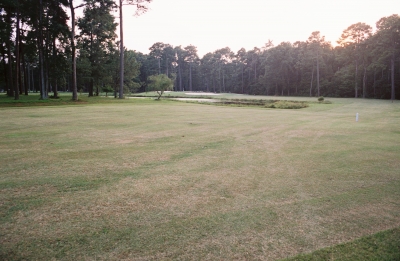 |
| Water guarding the green on the par-5 ninth hole will be extended father back on the left side of the fairway, demanding a heroic carry from those who go for the green in two shots. |
Cobb’s creation contains a good mix of long and short par-fours that bend both left and right. Two of the par-fives come at the ninth and eighteenth holes, providing distinctive punctuation marks to each nine. With two exceptions, the distance between holes is short, so it’s an easy course to walk. The course is blissfully free of intrusive housing.
Tucker’s renovation plan can be summed up in three words: Greens, drainage, irrigation. Greens will be rebuilt according to specifications developed by the agronomic specialists at the United States Golf Association. Unless you’re a total turf geek, the details about USGA green construction are about exciting about as, well, watching grass grow, so we’ll keep it short here.
Unlike pushup greens, USGA-spec greens have a subsurface drainage system built into them. Round or flat pipes are laid over the subgrade and then covered with a layer of gravel. Sometimes an intermediate layer of material is placed between the gravel and the root zone.
The root zone -- where the grass grows -- is like the icing on this layer cake, and is the part of the green containing all those mounds, dips, rolls and hogbacks that make putting such an adventure. Unlike Red Wing’s present greens, which tend to retain water after a rain, the new greens will let the water pass through -- an altogether healthier environment for the grass, both above and below ground.
Drainage is also a critical issue in Red Wing’s low-lying fairways. Tucker plans to move 125,000 yards of material in order to build up the fairways to a minimum of five feet.
“We’ll create berms in certain locations, and some undulations and some depressions. We’re going to capture water in each fairway and send it to some body of water or a major collection pipe. As soon as it rains, it’s underground. We’re designing to handle a five-year storm, which basically takes care of a two-inch rainfall,” said Tucker.
Because the golf course lies in a floodplain, no material can be brought onto the site to elevate the golf course. Mike White, the city’s project manager explained, ”What we’re doing is adding three lakes and expanding some of the existing lakes to offset the raising of the tees, the greens and the fairways.”
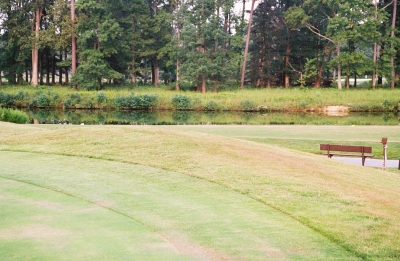 |
| Safety first: The new tee for the 11th hole will be moved across the water, out of harm's way from long approach shots to the 10th green. |
“We’ve addressed the things the city is concerned with. There’s no increase in flooding in the overall watershed. We’ve made available additional storage of stormwater in our lake system. And we’ve set up a wetland system that basically helps filter and clarify the water so we’re not increasing pollutant loading into Red Wing Lake.”
Tucker’ s firm is designing Red Wing’s irrigation system to minimize the use of fertilizers on the course. Known as fertigation, this system mixes fertilizer and other agronomic chemicals directly into water flowing through the irrigation system.
“With a fertigation system, you know that every ounce of fertilizer you’re putting out is going into the soil, not washing off the surface like granular applications,” said Tucker.
The new system will also help use water more efficiently. “It’ll have about 625 heads,” Tucker explained. “There will be dual heads around the greens. One set of heads will water the green surface; the other will water the perimeter around the greens. We’ll have all new pumps and pipes, and it’ll all be controlled by computer.”
A brand new maintenance compound will feature a storage barn for the grounds crew’s mechanical equipment. The chemical storage facility will also include a wash rack to capture runoff water after cleaning equipment.
The driving range and other practice areas, which are adjacent to the maintenance facility, will also be enlarged and improved.
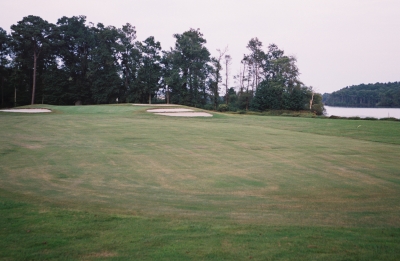 |
| Eyes right: The par-3 thirteenth hole will be shifted to the right, bringing Red Wing Lake more into play. |
Although Red Wing’s layout isn’t changing, the course will have a distinctly new look. Most of the bunkers will be removed in a nod to reducing maintenance costs and speeding up play. “With our berms around the greens, in strategic areas and doglegs, we’re really going to help the golfer keep the ball in play. It won’t have a dramatic effect on the low-handicapper who keeps it in the fairway,” said Tucker.
Adding new lakes and expanding existing ones will affect approach shots on the 6th, 9th and 18th holes. A new lake on the par-3 fourth hole will require every player to carry some water in order to reach the green. Greens will be shifted on two other par-threes, the 13th and 16th, bringing more water in play.
New tees on No. 16 will also redress an error made when Red Wing was first constructed. A drawing of the course hanging in the men’s locker room shows the tee complex with the back tees next to the water and providing the most severe line of play to the green. Unfortunately the original builders installed the tees in reverse, with the ladies’ tees closest to the water and the back tees providing the most favorable angle to the putting surface.
The par-five 14th hole will feature one of the most dramatic changes, as a new wetlands/lake complex will run along the right side of the fairway from tee to green, replacing a row of tall pine trees that offered some hope of escape for sliced shots.
In a safety-related move, the tees for the 11th hole will be relocated from their present position directly behind the 10th green to a new position on the other side of a lake. The shift in the teeing ground will turn what is now a straightaway par-four into a dogleg left hole.
The construction schedule announced in May 2004 called for the course to be closed from the fall of the present year to spring 2006. That’s going to have a ripple effect on players, maintenance personnel, volunteer marshals and the course’s professional staff.
J.B. San Giacomo, PGA professional at Red Wing, arrived in January 2000, following his tenure as head professional at Sleepy Hole Golf Course in Suffolk, Virginia. That course reopened in June 2004 following a $1 million renovation by Ault, Clark & Associates.
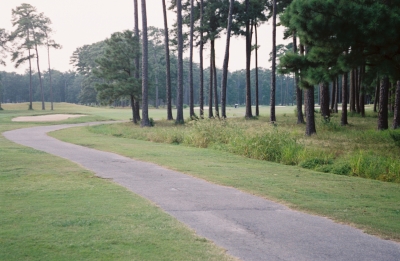 |
| No more great escapes: A band of trees on the right side of the 14th fairway will be replaced by wetlands running from the tee to a lake guarding the right side of the green. |
He bid on the Red Wing position knowing that “renovation had been mentioned, but there was no timetable.” That changed quickly.
“It started almost within a year,” said San Giacomo of the definitive events that would lead to official notice that Red Wing would be closed and renovated. During the last six months, his pro shop has featured an increasingly bare look and going out of business-style sale signs.
“Preparing hasn’t been easy,” he said. “Like any golf professional [in this situation], I’ve been watching the PGA’s employment bulletins.” Although the city’s other two municipal courses recently came up for bid, and San Giacomo submitted an offer, the incumbent pro was selected to keep running those operations. Asked what he would say to other PGA pros in a similar situation, San Giacomo replied simply, “Protect yourself first.”
As for Kevin Bennington’s greenskeeping crew, most will stay on during the renovation process and work around the edges of the golf course construction company’s crew. Some of the course’s marshals, like Rudy Hills, have had offers to work at other city courses.
“I’m not going to do it though,” said Hills, a former army man and Vietnam veteran, “I’m just going to kick back for a while and act retired.”
Red Wing’s regular players, including Sunday blitz stalwart Junior Asuega, have been making their plans too. “I’ll probably hop around to different courses like Heron Ridge or the TPC -- at least during the offseason while the rates are reduced,” he added with a laugh. A lot of the blitzers say they’ll return once Red Wing’s makeover is completed.
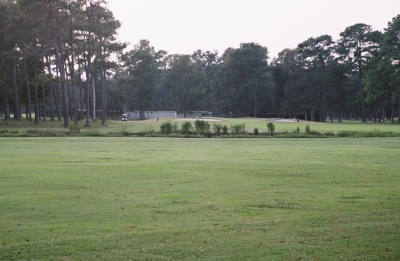 |
| Players attempting to cut the dogleg by flying the hazard on the par-4 seventeenth hole will discover a new expanse of water stretching up the left side of the fairway toward the green. |
When they do, they’ll find Red Wing transformed into 7,200 yards of newly sculpted beauty with six sets of tees. Tucker says players will be able to “bite off all you want or make it easy.”
The fairways, mostly free of bunkers, but edged by mounds and hillocks, and the teeing areas will be carpeted with lush 419 Bermudagrass turf. The greens will feature a 50/50 blend of A1 and A4 bentgrass.
Developed by the turfgrass scientists at Penn State University, these new strains of creeping bentgrass are heat tolerant, a crucial factor in the mid-Atlantic region.
The area is a transitional zone for growing turfgrass and the climate is a golf course superintendent’s nightmare. Summertime heat and humidity makes it hard to grow cool-weather grasses such as rye grass and older varieties of bentgrass, while the cool temperatures in winter cause traditional warm-weather grasses like Bermudagrass to go dormant and turn brown.
Modern varieties of bentgrass have been developed to stand up to summer’s steamy conditions. They develop deep roots and their upright growth pattern and narrow leaf blades result in a thick carpet of grass that can be mowed as short as 5/32 to 1/8 of an inch.
According to Kevin Bennington, who has been consulting with United States Golf Association agronomists, the new greens at Red Wing will share similar qualities with the area’s resort and private courses.
“We’ll have a dense, tight canopy of grass on the greens. Depending on how we manage them with mowing heights and top-dressing, we’ll be able to speed up or slow down the greens the way we want.”
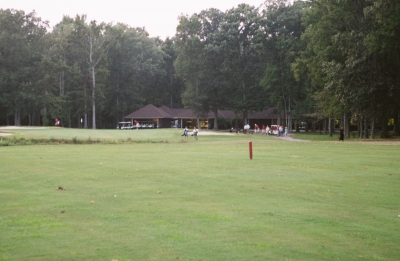 |
| More water: The eighteenth green will be shifted to the left, making room for a small bailout area on the right and an expansion of the pond in front of the putting surface. |
Asked about the blending of A1 and A4 varieties, Bennington responded, ”It’s a way of protecting the greens. With only one type of grass, a disease could wipe out the greens all at once. Having two strains of bentgrass reduces the chance of catastrophic loss.”
By spring 2006, Red Wing should be ready for her unveiling. She won’t be the cheap date she had become before her makeover, but players won’t have to dig too much deeper to go a round with her. City officials have said the green fees for residents will probably rise by less than $10. Ultimately, the market will set the rate. When Red Wing opened in 1971, the green fee for 18 holes was a mere $5.
When Red Wing once again welcomes players, she’ll be sporting a sleek, contemporary look. In place of flat fairways, scores of bunkers and old-fashioned greens, there will be undulating, well drained fairways and modern greens edged by catcher’s mitt mounds.
Behind her new face, Red Wing’s original George Cobb-designed bones will still stand out and provide the foundation for a challenging round of golf. Once again, the old girl’s dance card should be full of eager partners.
Details:
Note: The author lives less than three miles from Red Wing’s first tee and has been playing the course regularly, if not always well, since 1979.
Look for more reviews of Virginia Beach area golf courses down below.
| Related Links | Comments on this article? | |
|
Maryland National Golf Club Hollow Creek Golf Club Rocky Gap Resort PB Dye Golf Club in Ijamsville Whiskey Creek Golf Club |
E-mail Jeff Rendall, Editor: jrendall@golftheunitedstates.com |











